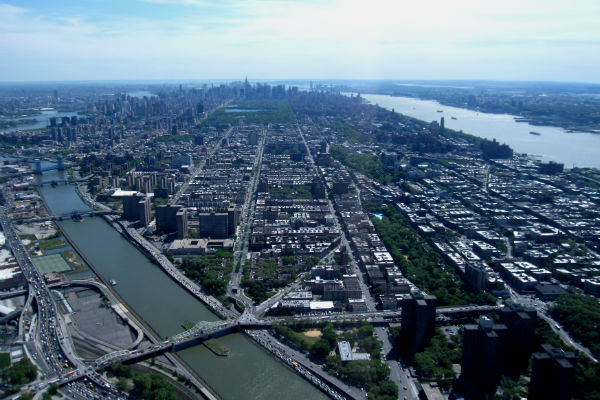 New York State today announced the release of draft criteria developed by the Climate Justice Working Group (CJWG) for identifying disadvantaged communities. The draft criteria will guide the equitable implementation of New York’s ambitious Climate Leadership and Community Protection Act (Climate Act – CLCPA).
New York State today announced the release of draft criteria developed by the Climate Justice Working Group (CJWG) for identifying disadvantaged communities. The draft criteria will guide the equitable implementation of New York’s ambitious Climate Leadership and Community Protection Act (Climate Act – CLCPA).
Pursuant to the Climate Act’s disadvantaged community provisions, the draft includes an interactive map and a list of communities the criteria would cover for directing programs and projects to reduce air pollution and climate-altering greenhouse gas emissions, provide economic development opportunities, and target clean energy and energy efficiency investments.
State Department of Environmental Conservation (DEC) Commissioner and Climate Action Council Co-Chair Basil Seggos said, “Advancing climate justice is central to New York’s Climate Act and our efforts to transition all New Yorkers to a cleaner, greener future. I thank the Climate Justice Working Group for the collaboration and extensive analysis that went into the draft disadvantaged communities list and criteria released today for public comment. This marks a significant milestone in New York’s efforts to advance climate justice and I encourage all New Yorkers to review these draft documents and support this ongoing work.”
New York State Energy Research Development Authority (NYSERDA) President and CEO and Climate Action Council Co-Chair Doreen M. Harris said, “Along with this draft criterion for disadvantaged communities, I encourage the public to review the Climate Action Council’s draft scoping plan and participate in the public hearings to shape the final product as we work to implement a bold climate agenda. These efforts are clearly and mindfully incorporating climate justice at its core to deliver opportunities and improved quality of life to under-resourced areas across New York State.”
The Climate Act requires the State to invest or direct resources to ensure that disadvantaged communities receive at least 35 percent, with the goal of 40 percent, of overall benefits of spending on clean energy and energy efficiency programs – one of several ways the Climate Act focuses on prioritizing climate justice.
The State’s CJWG, established by the Climate Act, voted unanimously to approve the release of draft criteria for public comment.
Comprised of 13 representatives from organizations working in frontline Environmental Justice communities across New York State and supported by a team of State agencies and technical experts, the CJWG worked to identify disadvantaged communities by evaluating 45 indicators including environmental exposures, burdens, and climate change risks; sociodemographic factors such as age, race, and income; pollution characteristics; and health vulnerabilities.
Using a methodology that worked at the census tract level, the working group combined and ranked all indicators into an overall score. DEC, NYSERDA, and the New York State Departments of Health and Labor supported the CJWG’s efforts.
In addition to the geographic component, the draft criteria include low-income households located anywhere in New York State for the purpose of investing or directing clean energy and energy efficiency programs, projects, and investments.
These individual households report annual total income at or below 60 percent of the State median income, or households otherwise eligible for low-income programs.
Criteria and methods for identifying disadvantaged communities will be reviewed annually to ensure the State is accurately targeting emissions reductions and investments.
“The Climate Justice Working Group has spent nearly two years working to create a definition and map of disadvantaged communities that captures the cumulative impact of communities’ experiences,” said Sonal Jessel, Director of Policy at Harlem‘s WE ACT for Environmental Justice and member of the CJWG.
“We have created and voted on a definition that centers race because we know from thousands of research studies that race is the number one indicator of environmental and climate health impacts, and I am excited to finally release the definition and map to the public so that we can further uplift community voices. Thank you to my fellow working group members and our partners at Illume Advising, as well as the DEC, NYSERDA, Department of Health, and other state agencies for getting us to this point.”
Eddie Bautista, Executive Director of the New York City Environmental Justice Alliance (NYC-EJA) and member of the CJWG, said, “Identifying communities that are disadvantaged is the first step in advancing the climate justice agenda outlined in the CLCPA. While we undertook an intensive process to develop these draft criteria, which included significant consideration and assessment of how communities are currently impacted by environmental burdens and health, income, and other social disparities; it is important to note that this is a starting point, and we should expect that these criteria will evolve over time as we collect more data and get better insight on the extent to which frontline communities across the state are overburdened. I am excited to hear feedback on these draft criteria from members of the public, including residents of frontline communities. I also want to express my appreciation to my fellow working group members for their dedication to the process and helping us get to this point.”
Rahwa Ghirmatzion, Executive Director of PUSH Buffalo and member of the CJWG, said, “I’m grateful for the leadership of DEC and NYSERDA for showing the courage to work with frontline leadership through a rigorous process with the Climate Justice Working Group to develop this draft criterion for identifying disadvantaged communities. While the goal is to continue to iterate, evolve, and deepen how we characterize disadvantaged communities over time to meet the goals as intended by the architects of the CLCPA, this initial draft is a great place to start.”
DEC is accepting public comments until July 7, 2022, on the draft criteria and will hold at least six public hearings during the comment period. The draft criteria, community list, map, and supporting documentation are available on the New York State Climate Act website.
New Yorkers are encouraged to submit comments via the online public comment form, via email at DACComments@dec.ny.gov, and via U.S. Mail to Attention: Draft DAC Comments, NYS DEC, Attn. Office of Environmental Justice, 625 Broadway, 14th Floor, Albany NY 12233. Information about the public hearings will be released soon.
The Climate Act requires that the Climate Action Council’s Scoping Plan prioritize and maximize reduction of greenhouse gases and co-pollutants in disadvantaged communities. The Climate Action Council’s Draft Scoping Plan was released for public comment on Jan. 1, 2022.
The draft plan provides several scenarios for the Climate Action Council to consider recommending policies and actions to help New York meet its ambitious climate directives.
The Draft Scoping Plan is available for public review and comment, and the Climate Action Council will also hold a series of public hearings.
For more information about the Draft Scoping Plan, or to submit comments or learn more about upcoming public hearings, visit the Climate Act website.
New York State’s nation-leading climate agenda is the most aggressive climate and clean energy initiative in the nation, calling for an orderly and just transition to clean energy that creates jobs and continues fostering a green economy as New York State recovers from the COVID-19 pandemic.
Enshrined into law through the CLCPA, New York is on a path to achieve its mandate of a zero-emission electricity sector by 2040, including 70 percent renewable energy generation by 2030, and to reach economy-wide carbon neutrality.
It builds on New York’s unprecedented investments to ramp-up clean energy including over $33 billion in 102 large-scale renewable and transmission projects across the state, $6.8 billion to reduce buildings emissions, $1.8 billion to scale up solar, more than $1 billion for clean transportation initiatives, and over $1.6 billion in NY Green Bank commitments.
Combined, these investments are supporting nearly 158,000 jobs in New York’s clean energy sector in 2020, a 2,100 percent growth in the distributed solar sector since 2011, and a commitment to developing 9,000 megawatts of offshore wind by 2035.
Under the Climate Act, New York will build on this progress and reduce greenhouse gas emissions by 85 percent from 1990 levels by 2050, while ensuring that at least 35 percent with a goal of 40 percent of the benefits of clean energy investments are directed to disadvantaged communities and advance progress towards the state’s 2025 energy efficiency target of reducing on-site energy consumption by 185 trillion BTUs of end-use energy savings.
Photo credit: Sonal Jessel at source.
Become a Harlem Insider!
By submitting this form, you are consenting to receive marketing emails from: . You can revoke your consent to receive emails at any time by using the SafeUnsubscribe® link, found at the bottom of every email. Emails are serviced by Constant Contact








